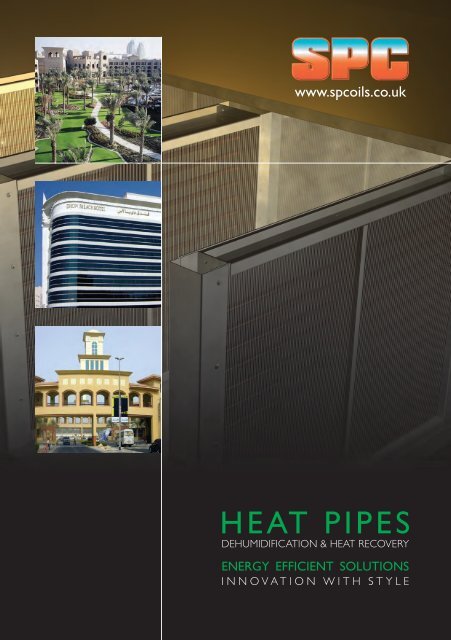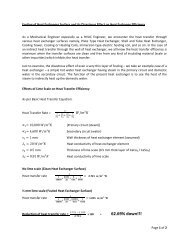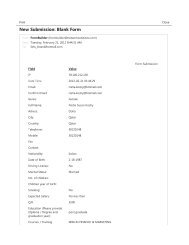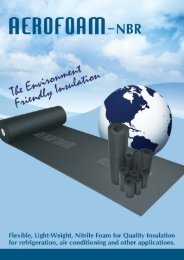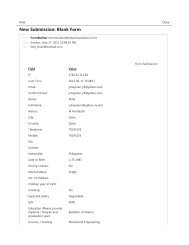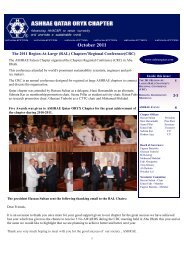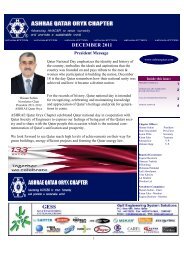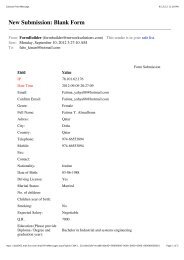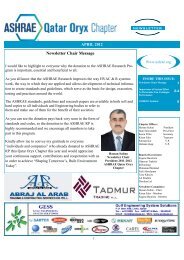HEAT PIPES - S & P Coil Products Limited
HEAT PIPES - S & P Coil Products Limited
HEAT PIPES - S & P Coil Products Limited
- No tags were found...
You also want an ePaper? Increase the reach of your titles
YUMPU automatically turns print PDFs into web optimized ePapers that Google loves.
TECHNOLOGYSPC <strong>HEAT</strong> <strong>PIPES</strong> for Dehumidification and Heat RecoveryTechnology<strong>HEAT</strong> <strong>PIPES</strong> are the most effective passive method of transferring heat available today. In their simplestform, a sealed tube (usually copper) is evacuated and charged with a working fluid. In the case of <strong>HEAT</strong><strong>PIPES</strong> for HVAC purposes, refrigerants such as R134A are currently used. Heat transfer occurs without theneed for energy input.BASIC OPERATIONThis diagram shows the basic structure of a heat pipe andidentifies the major steps in the heat pipe process. Heat isabsorbed from the incoming warm air stream in the evaporatorsection, boiling the refrigerant. Due to it's elevated vapourpressure, the vapour moves rapidly to the cooler condensersection of the heat pipe, carrying with it the absorbed heat.As the vapour reaches the condensing area of the heat pipe,heat is released to the cooler air and the vapour condenses.The liquid returns by gravity to complete the cycle. The entireheat transfer process occurs with a very small temperaturedifference along the pipe.Apart from air conditioners, <strong>HEAT</strong> <strong>PIPES</strong> have been used inmany applications, including the cooling of casting dies, electroniccircuitry, nuclear powered generators, energy conservation,defrosting applications and in the food industry.4S & P <strong>Coil</strong> <strong>Products</strong> reserve the right to amend specification whilst pursuing a policy of continualimprovements in performance and design.
SPC <strong>HEAT</strong> <strong>PIPES</strong> for Dehumidification and Heat RecoveryDehumidificationWhen applied to HVAC, <strong>HEAT</strong> <strong>PIPES</strong> provide significant dehumidification enhancement and improvedindoor air quality. The additional benefit of energy saving occurs in many situations, especially where reheatis required. Depending on conditions, <strong>HEAT</strong> <strong>PIPES</strong> can double the amount of moisture removed by an airconditioner's cooling coil.By circuiting <strong>HEAT</strong> <strong>PIPES</strong> in sections before and after the cooling coil (as above diagram) heat is removedfrom the air stream before it encounters the cooling coil. This passively pre-cooled air means less sensiblecooling is required by the coil, providing more latent capacity, and superior dehumidification ability. The now"over-cooled" air passes across the re-heat section of the heat pipe, bringing the air temperature to acomfortable supply condition.This free reheat is provided by the same heat energy which was absorbed from the incoming air stream. Inthe case of fresh air treatment, <strong>HEAT</strong> <strong>PIPES</strong> can be used to pre-cool the incoming outside air before it iscooled and dehumidification by the cooling coil. The heat pipes then reheat the air to the "neutral" supplytemperature.<strong>HEAT</strong> <strong>PIPES</strong> are particularly useful in displacement ventilation systems where air is supplied directly intothe occupied space at low level. When combined with ceiling cooling systems the primary air must bedehumidified to prevent sweating of the ceiling as well as reheated to a few degrees below the spacetemperature. Incorporation of heat pipes allows substantial energy saving to be realised.5DEHUMIDIFICATION
DEHUMIDIFICATIONSPC <strong>HEAT</strong> <strong>PIPES</strong> for Dehumidification and Heat RecoveryDehumidification<strong>HEAT</strong> <strong>PIPES</strong> AS APPLIED TO AIR CONDITIONINGThe cooling coil in the standard air conditioner provides both sensible and latent cooling. The followingchart shows how the heat pipe provides pre-cooling before the cooling coil. This then increases the latentcooling ability of the coil before the heat pipe re-heats the air back up to a comfortable condition.Using <strong>HEAT</strong> <strong>PIPES</strong> will increase the latent cooling capacity at reduced cost.COOLING WITH <strong>HEAT</strong> <strong>PIPES</strong>BENEFITS AND COST ADVANTAGESApart from the above indirect cost savings, <strong>HEAT</strong> <strong>PIPES</strong> have no moving parts to break or wear out andare virtually maintenance free. Because of simplicity in design, <strong>HEAT</strong> <strong>PIPES</strong> will most likely outlast the airconditioning equipment itself.Because the cooling coil has less work to do, a reduction in size of coil may be achievable. Also the heatpipe is not using any external energy, so is effectively free to operate. As a result very short pay-backs canbe achieved.6S & P <strong>Coil</strong> <strong>Products</strong> reserve the right to amend specification whilst pursuing a policy of continualimprovements in performance and design.
<strong>HEAT</strong> RECOVERYSPC <strong>HEAT</strong> <strong>PIPES</strong> for Dehumidification and Heat RecoveryHeat Recovery<strong>HEAT</strong> <strong>PIPES</strong> FOR <strong>HEAT</strong> RECOVERYWith increasing demands for energy efficient buildings, it is essential that energy is not wasted. Utilising aheat pipe, thermal energy can be recovered from warmer air and added to cooler air. In temperateclimates this permits energy saving to be realised through preheating of the outside air. Conversely, in hotclimates the savings are associated with pre-cooling of the outside air.<strong>HEAT</strong> <strong>PIPES</strong> can be arranged with airstreams side by side using tubes sloping down to the warmer air.Alternatively the air streams can be stacked with the warmer airstream at the bottom. This coupled withflexibility of sizing to suit the ductwork or air handling unit makes <strong>HEAT</strong> <strong>PIPES</strong> the ideal heat recovery solution.BASIC COMPARISON INFORMATIONMany types of heat exchangers are available for heat recovery applications. However each type of heatexchanger has certain advantages and drawbacks:RUN-AROUND COILS are relatively inexpensive, but require a pump pack and expansion tank tooperate. Run-around loops used in cold climates must be charged with anti-freeze to prevent frost damage.They are however the best solution for 'separate' air streams.PLATE TO PLATE heat exchangers are quite effective, but are bulky, expensive and very difficult to clean.They can trap condensate resulting in the growth of moulds.<strong>HEAT</strong> RECOVERY WHEELS are maintenance intensive and prone to cross contamination and do noteffectively drain condensation.Only <strong>HEAT</strong> <strong>PIPES</strong> offer all the benefits combined: no moving parts, high effectiveness, low air-pressure drop,easy drainage of condensation, no direct energy requirement and zero cross-contamination. They are alsoproven to be long lasting and virtually maintenance-free.Additionally, <strong>HEAT</strong> <strong>PIPES</strong> can be treated to withstand corrosive environments such as swimming pools andsome process applications.8S & P <strong>Coil</strong> <strong>Products</strong> reserve the right to amend specification whilst pursuing a policy of continualimprovements in performance and design.
SPC <strong>HEAT</strong> <strong>PIPES</strong> for Dehumidification and Heat RecoveryControllable Heat PipesWhenever <strong>HEAT</strong> <strong>PIPES</strong> are used in the treatment of outside air they should be utilised to their fullpotential in order to maximise the energy savings that they provide. This is achieved by the use of standarduncontrolled <strong>HEAT</strong> <strong>PIPES</strong>.In certain specialised applications, however, it may be beneficial to take advantage of the options foradditional control that can be offered. For example, should the SHR of the load that is being treated varymarkedly then the heat pipe performance can be controlled to match the process load to the system load.The best means of achieving this is via the use of a secondary cooling coil which can be supplied integralto the heat pipe and acts to offset the reheat.It should be borne in mind that the additional costs and complexity associated with controllable<strong>HEAT</strong> <strong>PIPES</strong> cannot normally be justified for use with 100% outside air units. In the vast majority of suchcases the heat pipe should be allowed to run wild in order to maximise the moisture removal capacity ofthe system with the only control being over the cooling coil.Please contact SPC for assistance with your enquiries; advice will be given regarding the most suitablesystem for your application.SOFTWAREA range of self selection software is available free of charge from SPC. These are freely downloadable fromour website www.spcoils.co.uk or on CD-Rom. These include calculations of pay back periods in addition tounit selection.APPLICATION NOTESThe use of <strong>HEAT</strong> <strong>PIPES</strong> for enhanced dehumidification, heat recovery and displacement ventilation systemsis discussed in detail in SPC's range of Application Notes. Please contact our Technical Sales Team for yourcopy, or alternatively download them freely from our website.CPD PRESENTATIONSPC are able to offer a presentation on <strong>HEAT</strong> <strong>PIPES</strong> and their application in the HVAC industry. Pleasecontact our office for further details.9SOFTWARE
EXAMPLESSPC <strong>HEAT</strong> <strong>PIPES</strong> for Dehumidification and Heat RecoveryExamplesROYAL MIRAGE, DUBAICONVENTION CENTRE, DUBAIDHOW PALACE, DUBAIDUBAI BANKEXHIBITION HALLS, DUBAIEMMAR HQ, DUBAI10S & P <strong>Coil</strong> <strong>Products</strong> reserve the right to amend specification whilst pursuing a policy of continualimprovements in performance and design.
SPC <strong>HEAT</strong> <strong>PIPES</strong> for Dehumidification and Heat RecoveryExamplesEXAMPLESGOLF TOWERS, DUBAIEXPRESS BY HOLIDAY INN, DUBAIKNOWLEDGE VILLAGE, DUBAILOB BUILDINGS, DUBAIMADINAT JUMEIRAH, DUBAIMANKHOOL TOWER, DUBAI11
S & P <strong>Coil</strong> <strong>Products</strong> <strong>Limited</strong>SPC House, Evington Valley Road, Leicester LE5 5LUTel: +44 (0)116 249 0044 Fax: +44 (0)116 249 0033email: spc@spcoils.co.ukwww.spcoils.co.ukDubai Sales OfficeTel: +971-4-3341178Fax: +971-4-3341179India Sales OfficeTel: +91-9871134081Fax: +91-11-25612281 Ref: HP1 Issue 4


